NRL to Schematron generator tutorial
Created by Adriana Alexandru
Contents
- Overview - purpose of document
- Resources
- Setup
- NRL to Schematron mapping explained
- Step by step example of building a
NRL to Schematron generator
- Writing the test cases
- Writing the fixture
- Implementation of test cases
- NRL to Schematron generator
implementation
- Download java source code of this
example
- Limitations
This document is a guide to creating a NRL to Schematron
generator and presents an end-to-end generator example and the reasoning
behind it.
-
Resources for NRL can be found on the NRL Sourceforge
page.
-
Looking at this very useful overview of how Schematron works might be
a good start. Resources for Schematron can be found on the official website
of Schematron and a Schematron tutorial is also available.
-
The Concordion official website offers a very comprehensive tutorial
about how Concordion works.
-
The software programs used in this tutorial are Eclipse
version 3.6.1 and Oxygen
XML Editor.
The NRL parser and Concordion need to be installed before starting.
Dependencies are managed with Maven.
Since the NRL parser is developed in Java this tutorial uses
Java to build a NRL to Schematron generator example.
-
Oxygen XML Editor is used in order to visualise the XML schema
model when creating the NRL rules examples that are mapped to
Schematron rules. It is useful to build the Oxygen XML Editor project
in the Eclipse project in order to easily manage all the files. Below
two screenshots show how files were organised for this tutorial in
Eclipse and Oxygen XML Editor.
| Eclipse screenshot |
Oxygen XML Editor screenshot |
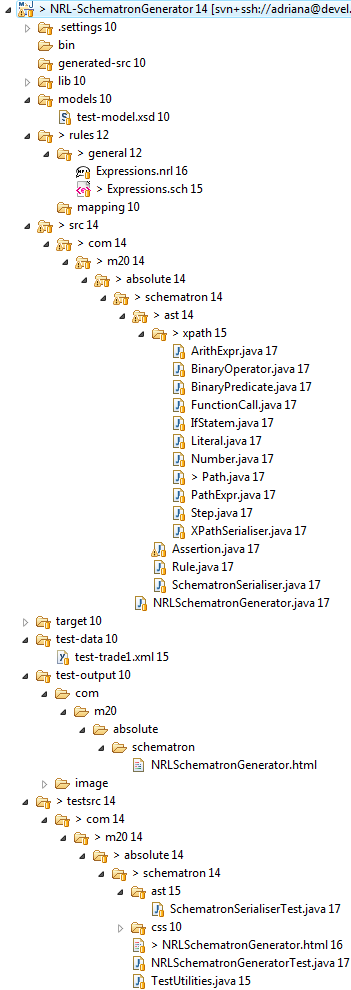 |
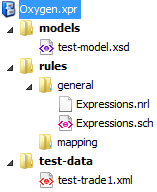 |
Note that the models, rules and test-data
folders in the Eclipse navigation screenshot that are the same with the
Oxygen XML Editor folders.
The src/com/m20/absolute/schematron/ast/xpath package
contains the classes relevant to translating NRL language constraints
to XPath. XPath is relevant because the assert element in
Schematron contains an attribute test whose value is expresssed
in XPath.
The src/com/m20/absolute/schematron/ast package contains
the classes used to translate NRL rules into Schematron rules.
For the purpose of easy file management the folder in which
Concordion outputs the result html file has been changed to test-output/com/m20/absolute/schematron
and the file is called NRLSchematronGenerator.html. This file
displays the Concordion test cases and whether they pass or fail and
works in the same way as it is explained in the Concordion
tutorial.
The testsrc/com/m20/absolute/schematron/css package
contains the NRLSchematronGeneratorTest.java file which
represents the Concordion fixture which is also explained in the same
Concordion tutorial. The NRLSchematronGenerator.html within this
package is the file in which the test cases are written.
The mapping examples displayed below use the
XML Schema model displayed below in a visual manner as a screenshot via
Oxygen XML Editor.
NRL works on the basis of types rather than elements. So when referring to Trade
for example, Trade is a type, and
same with Amount. Because the Trade type is used in this
tutorial it is also expanded and displayed visually below. Please ignore
the highlights for now.
| XML schema model |
Trade type expanded |
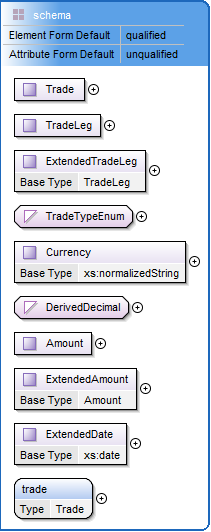 |
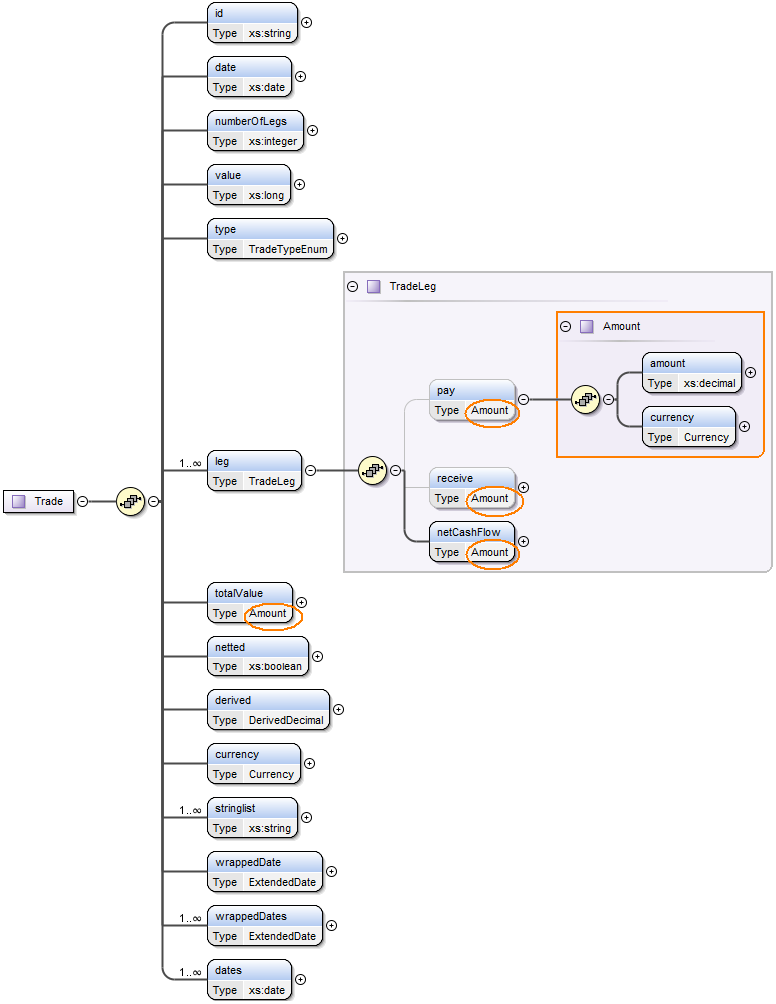 |
The easiest way to learn how NRL is mapped to Schematron is to
look at an example. Since NRL rules map to a model, the XML schema is used to create a XML file model on which the NRL rule will be
created agaist.
The table displayed below shows how two NRL rules are mapped to
Schematron.
| Example files |
NRL |
Schematron |
Comments |
NRL rule
Schematron rule |
Rule Set "Expressions"
Context: Trade
Validation Rule "r1"
numberOfLegs = 6 |
<?xml version="1.0" encoding="UTF-8"?>
<schema xmlns="http://www.ascc.net/xml/schematron">
<pattern name="Expressions">
<rule context="//trade" id="r1">
<assert test="numberOfLegs = 6" />
</rule>
</pattern>
</schema>
|
- It is straightforward to observe that:
- The NRL Rule Set is mapped to a pattern
element in Schematron.
- The NRL Validation Rule is mapped to the rule
element.
- The name of the NRL Rule Set becomes the value of the
attribute name of the pattern element in Schematron.
- The NRL rule ID is becomes the value of the id
attribute of the rule element in Schematron.
- The constraint of the NRL rule is translated in an XPath
expression and this expression becomes the value of the test
attribute of the assert element in Schematron. This involves
mapping the NRL expressions as much as possible to XPath and is
probably the most time consuming part of creating the generator
depending on the scope of NRL desired to be translated. This tutorial
covers some common expressions translations such as arithmetic
expressions, boolean operators, binary predicates; this is covered in
detail in the next section.
- In NRL the rule Context refers to the immediate upper
type in the model hierarchy. In this example it is straightforward to
observe looking at the expanded diagram
of the Trade type displayed above that the immediate upper type in
the hierarchy for numberOfLegs from the NRL rule constraint is
Trade. In Schematron, it is not possible to specify a type as
a rule context. To solve this, the model needs to be recursively
seached for all nodes that have this type and the paths to these
nodes are expressed in XPath format and they represent the value of
the context attribute of the rule element in
Schematron. In this example, it is easy to observe that in the model
that the Trade itself is the only node of type Trade; so in XPath
this is //trade. The NRL to Schematron context translation is
explained again in the example displayed below in order to make it
all clear.
|
NRL rule
Schematron rule |
Context: Amount
Validation Rule "r2"
amount >= 10000 |
<rule context="//trade/leg/pay | //trade/leg/receive |
//trade/leg/netCashFlow | //trade/totalValue" id="r2">
<assert test="amount >= 10000"/>
</rule>
|
In this example the NRL rule context is Amount because
the rule constraint is evaluating the value of amount and the
immediate upper type in the hierarchy for amount is Amount
(note that, for example, an immediate upper node of amount in
the hierarchy is the pay node in the model
diagram which is of type Amount).
It is highlited in the diagram that more nodes of type Amount
exist: pay, receive, netCashFlow, totalValue.
It is also highlited that a node of type Amount contains the
nodes amount and currency. This means that in this
example the rule is evaluating the value of amount in 4 places
in the model since amount is contained by the type Amount
and 4 nodes as highlighted have this type. This explains why the NRL
context translated to Schematron context includes the paths to these
nodes in XPath format as displayed in the Schematron rule.
(Note: this expansion of types into paths would not be
necessary if we were to use Schematron with XPath 2 - we decided to
stick to version 1 for this tutorial)
|
The NRL to Schematron rule translation is probably the most
common translation that needs to be done and it suffices for the purpose
of this tutorial. A NRL to Schematron generator might attempt to
generate Schematron reports as well.
The diagram displayed below shows the entire generatiom
implementation workflow: The input is NRL code. The NRL code is parsed
by the NRL parser into a NRL AST. The NRL AST is translated into a
Schematron AST. The Schematron AST is serialised by the Serialiser. The
Serialiser produces the Schematron code which is the final output.

The beauty of using Concordion to build the generator is that the
specifications are tied to the implementation thus and the system is
documented and the code is neat.
A preferred way of starting to build the generator is by starting
with writing the specifications, more exactly in this case, by writing
the test cases. Here is a link to the final
Concordion validated test cases, which are also displayed below, which
will show exatcly what it is aimed to be obtained. All the
implementation sits behind the green colours from these two tables.
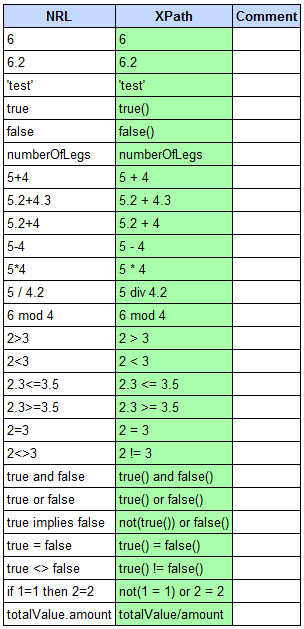 |
 |
-
Writing these test cases follow the same procedure described in
the Concordion tutorial mentioned above. The
test cases are written in a html file which is tied to the fixture as
showed in the tutorial. Here is the html code for the NRLSchematronGenerator.html
file used to build this generator example. There is no need to write
all the possible test cases from the beginning, test cases can always
be added later .
Starting by writing some test cases helps to narrow down
implementation focus on the NRL constraints specified to be translated.
The first column from both tables represents the expression or
rule correctly written in NRL. The second column represents the same
concept but translated to Schematron and this is what the
implementation is expected to produce. The third column is optional for
specifying any comments if desired. Obviously, this structure can be
changed to add more columns or to not use tables at all. This example
uses tables for test cases to maximise the clarity of the translations.
-
The next step is to write the fixture file that will map the
test cases to their implementations. The fixture documented java
source code for this example of generator is available for download.
Writing the fixture class is straightforward and the Concordion
tutorial mentioned above explains how to write fixture classes.
-
Each test case written at Step 1 needs to
be implemented correctly in order to be validated by Concordion and
coloured in green, otherwise it is coloured in red. The implementation
needs to be serialised to generate the same output as the one written
in the second column of the html test cases for Schematron as expected
generated output.
The first test case from the first table, for example, says that
a number, for example number 6 in NRL is 6 in NRL and in
Schematron is 6 too. A class that allows to express numbers
needs to be created. The class needs to implement methods to set the
value of the number an to retrieve it. Here is the java source code for Number.java class
which validates the first test case.
Other test cases may require the use of a serialiser method to
format the output as desired. It is recommended to keep the serialiser
methods separate in a different class from the implementation. An
example of such test case that requires a serialiser is 5 / 4.2
which is translated from NRL to Schematron as 6 div 4.2. The
implementation is in the java class BinaryPredicate.java
and the serialiser method is in the XPathSerialiser.java.
The code is documented and comprehensive. The serialiser method
relevant for this test case is the method that takes as parameter an
instance of a BinaryPredicate.
The second table uses a different serialiser class, SchematronSerialiser.java
for clarity.
All implementation code for the test cases
introduced above in the two tables is available for download and is
documented and comprehensive.
-
The last step is to write the generator itself. The NRL to Schematron generator
class, NRLSchematronGenerator.java, makes use of all the classes
written for implementing the test cases. This class can be continously
expanded as translations as test cases are implemented. This class will
run as a JUnit test as described in the Concordion tutorial.
Here is the link to download
the entire project including the source code and this tutorial. If you are using eclipse,
you can import this as an eclipse project. It requires the NRL parser, which you can find on the
sourceforge page.
In conclusion: this document attempts to explain how to translate a part of
the NRL language to Schematron. It is not supposed to be a full code generator, and therefore
neither implements all of NRL, nor all of Schematron. Nevertheless, we hope this was useful to you as an example
of working with the NRL API and what is involved in writing a code generator.
Let us know on the nrl-dev list!.






